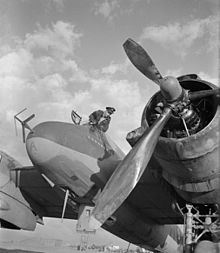 Group Captain "Paddy" Green achieved most of his 11 confirmed kills in this Mk. IV-equipped Beaufighter. | |
| Country of origin | UK |
|---|---|
| Introduced | 1940 |
| Type | Aircraft interception |
| Frequency | 193 MHz (VHF) |
| PRF | 750 pps |
| Beamwidth | ~175 degrees |
| Pulsewidth | 2.8 μs |
| Range | 400–18,000 feet (120–5,490 m) |
| Precision | 5 degrees |
| Power | 10 kW |
| Other Names | AIR 5003, SCR-540 |
Radar, Aircraft Interception, Mark IV (AI Mk. IV), also produced in the USA as SCR-540, was the world's first operational air-to-air radar system. Early Mk. III units appeared in July 1940 on converted Bristol Blenheim light bombers, while the definitive Mk. IV reached widespread availability on the Bristol Beaufighter heavy fighter by early 1941. On the Beaufighter, the Mk. IV arguably played a role in ending the Blitz, the Luftwaffe's night bombing campaign of late 1940 and early 1941.
Early development was prompted by a 1936 memo from Henry Tizard on the topic of night fighting. The memo was sent to Robert Watson-Watt, director of the radar research efforts, who agreed to allow physicist Edward George "Taffy" Bowen to form a team to study the problem of air interception. The team had a test bed system in flights later that year, but progress was delayed for four years by emergency relocations, three abandoned production designs and Bowen's increasingly adversarial relationship with Watt's replacement, Albert Rowe. Ultimately, Bowen was forced from the team just as the system was finally maturing.
The Mk. IV series operated at a frequency of about 193 megahertz (MHz) with a wavelength of 1.5 metres, and offered detection ranges against large aircraft up to 20,000 ft (3.8 mi; 6.1 km). It had numerous operational limitations, including a maximum range that increased with the aircraft's altitude and a minimum range that was barely close enough to allow the pilot to see the target. Considerable skill was required of the radar operator to interpret the displays of its two cathode-ray tubes (CRTs) for the pilot. It was only with the increasing proficiency of the crews, along with the installation of new ground-based radar systems dedicated to the interception task, that interception rates began to increase. These roughly doubled every month through the spring of 1941, during the height of the Blitz.
The Mk. IV was used operationally for only a short period. The introduction of the cavity magnetron in 1940 led to rapid progress in microwave-frequency radars, which offered far greater accuracy and were effective at low altitudes. The prototype Mk. VII began to replace the Mk. IV at the end of 1941 and AI Mk. VIII largely relegated the Mk. IV to second-line duties by 1943. The Mk. IV's receiver, originally a television receiver, was used as the basis of the ASV Mk. II radar, Chain Home Low, AMES Type 7, and many other radar systems throughout the war.